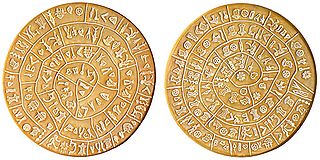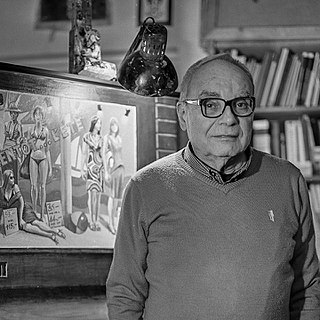
Volterra is a walled mountaintop town in the Tuscany region of Italy. Its history dates from before the 8th century BC and it has substantial structures from the Etruscan, Roman, and Medieval periods.

Achille Bonito Oliva is an Italian art critic and historian of contemporary art. Since 1968 he has taught history of contemporary art at La Sapienza, the university of Rome. He has written extensively on contemporary art and contemporary artists; he originated the term Transavanguardia to describe the new direction taken in the late 1970s by artists such as Sandro Chia, Francesco Clemente, Enzo Cucchi, Nicola De Maria, and Mimmo Paladino. He has organised or curated numerous contemporary art events and exhibitions; in 1993 he was artistic director of the Biennale di Venezia.

Giambattista Pittoni or Giovanni Battista Pittoni was a Venetian painter of the late Baroque or Rococo period. He was among the founders of the Academy of Fine Arts of Venice, of which in 1758 he became the second president, succeeding Tiepolo.
Giovanni Becatti was an Italian Classical art historian and archaeologist.

Antonio Balestra was an Italian painter of the Rococo period.

Giacomo Boni was an Italian archaeologist specializing in Roman architecture. He is most famous for his work in the Roman Forum.
Gianfranco Goberti was an Italian painter.

Alessandra Melucco Vaccaro was an Italian historian and archaeologist. Her main activity was in the three fields in which she made significant innovations - the High Middle Ages, archaeological restoration, and environment and landscape. President Carlo Azeglio Ciampi conferred the Medaglia d'Oro for culture and art in Vaccaro's memory in February 2001.

Luigi Pernier was an Italian archaeologist and academic now best known for his discovery of the Disc of Phaistos.

Francesco Mancini was an Italian painter whose works are known between 1719 and 1756. He was the pupil of Carlo Cignani.

Ettore Tito was an Italian artist particularly known for his paintings of contemporary life and landscapes in Venice and the surrounding region. He trained at the Accademia di Belle Arti in Venice and from 1894 to 1927 was the Professor of Painting there. Tito exhibited widely and was awarded the Grand Prize in painting at the 1915 Panama–Pacific International Exposition in San Francisco. In 1926 he was made a member of the Royal Academy of Italy. Tito was born in Castellammare di Stabia in the province of Naples and died in Venice, the city which was his home for most of his life.
Ernesto Treccani was a visual artist, writer and political activist.

Sergio Ceccotti is an Italian painter. He lives and works in Rome.
Mario Salmi was an Italian art historian and art critic who specialized in Romanesque architecture, Tuscan sculpture and the early Italian Renaissance.

The Polo Museale del Lazio is an office of Italy's Ministry of Cultural Heritage. Its seat is in Rome in the Palazzo Venezia.

Enrico Crispolti was an Italian art critic, curator and art historian. From 1984 to 2005, he was professor of history of contemporary art at the Università degli Studi di Siena, and director of the school of specialisation in art history. He previously taught at the Accademia di Belle Arti in Rome (1966–1973) and at the Università degli Studi di Salerno (1973–1984). He was author of the catalogues raisonnés of the works of Enrico Baj, Lucio Fontana and Renato Guttuso. He died in Rome on 8 December 2018.

The Museo di Roma is a museum in Rome, Italy, part of the network of Roman civic museums. The museum was founded in the Fascist era with the aim of documenting the local history and traditions of the "old Rome" that was rapidly disappearing, but following many donations and acquisitions of works of art is now principally an art museum. The collections initially included 120 water-colours by the nineteenth-century painter Ettore Roesler Franz of Roma sparita, "vanished Rome", later moved to the Museo di Roma in Trastevere.

Alik Cavaliere (1926–1998) was an Italian sculptor. He spent his life researching the meaning of life, freedom, nature, and history. An atheist and libertarian, he didn't believe in any preconceived, final structure of society, the environment, or the universe. Nor did he follow any art movements of his time, although he knew all of them and was temporarily influenced by some. He made his own way, narrating his perceptions with witty irony, through sculptures made up of a wide range of materials, disposed in a chaotic labyrinth which visitors are forced to traverse without being able to find a definitive point of view.

The Italian Numismatic Institute is an Italian body for the study of numismatics, based in Palazzo Barberini at 13 via Quattro Fontane.















